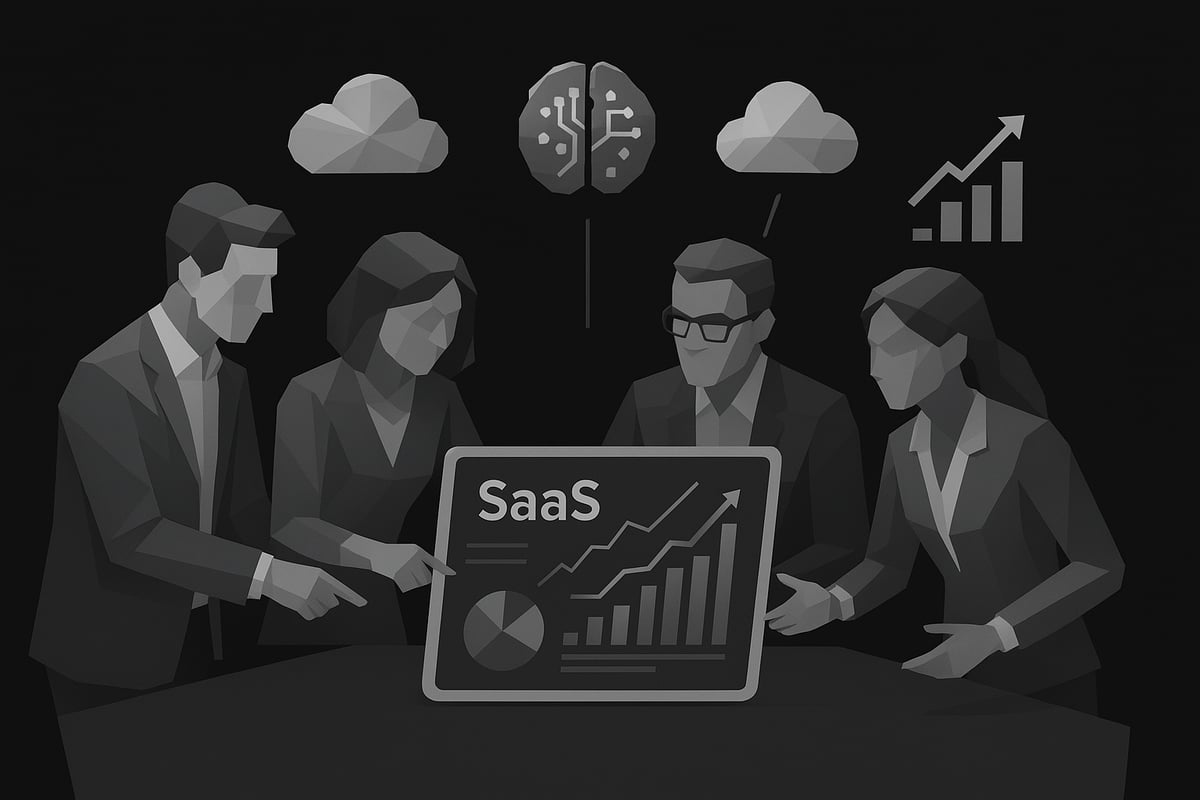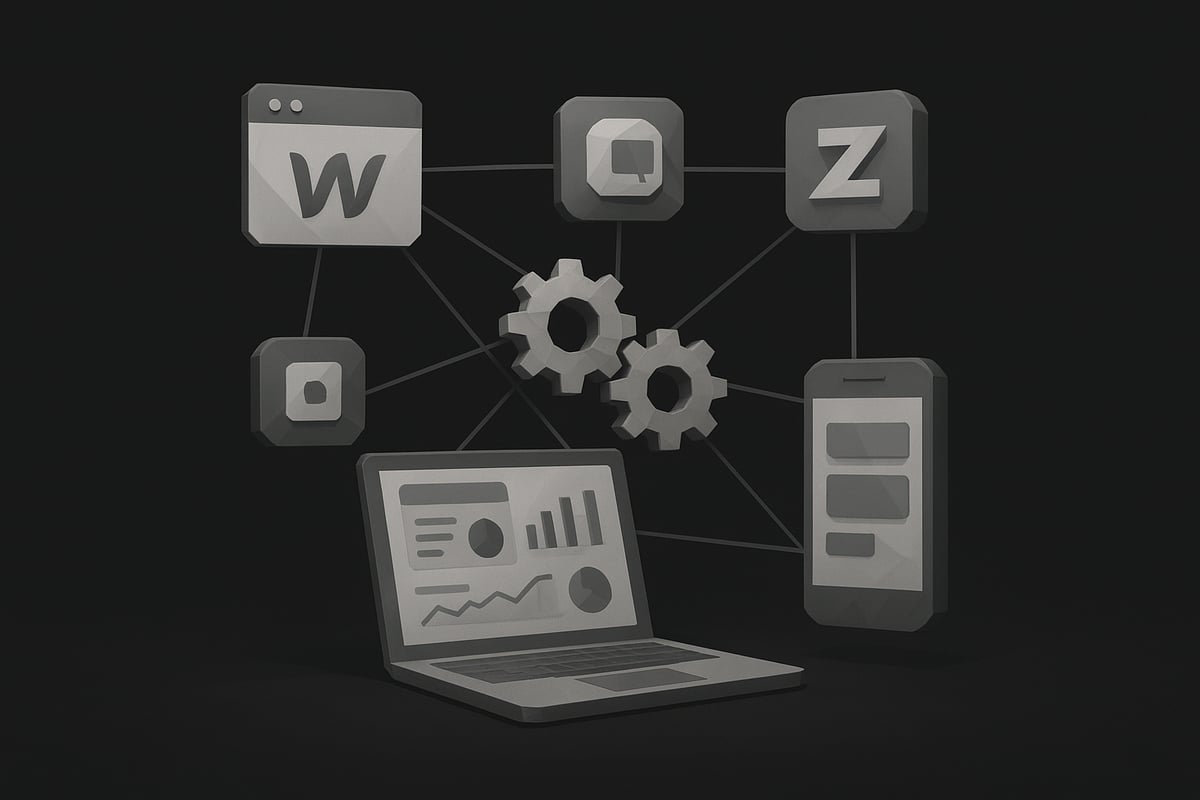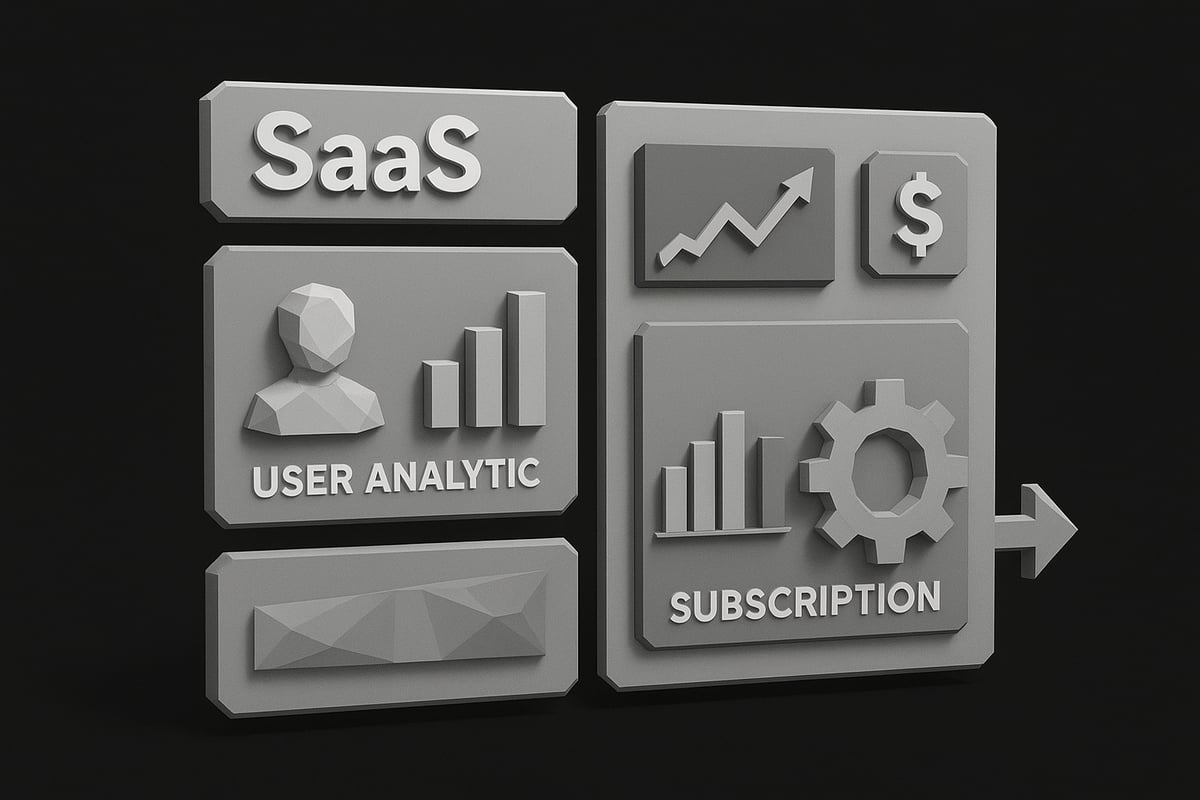Imagine launching a profitable SaaS business in 2025, all without writing a single line of code. The $195 billion SaaS market is booming, and the barriers to entry are falling fast.
This guide will empower you to build, validate, and launch a successful no code saas, even if you have no technical background. You'll learn about the latest no code trends, step-by-step building strategies, top platforms, validation tactics, launch essentials, and future predictions.
Ready to turn your idea into a scalable SaaS product? Follow this guide and confidently launch your own no code saas in 2025.
The No Code SaaS Revolution: Trends and Opportunities in 2025
The no code saas revolution is transforming how businesses and entrepreneurs approach software development. In 2025, the combination of accessible technology and rapid innovation is making it easier than ever to launch scalable SaaS solutions, regardless of technical background.

Explosive Growth of No Code and SaaS
The no code saas market is experiencing exponential growth. SaaS revenue surpassed $195 billion in 2023, and projections for 2025 remain strong as more founders enter the space. No-code platforms are lowering entry barriers, empowering individuals to create software without traditional programming skills.
AI-powered no code saas tools are accelerating product development and enabling faster iteration cycles. Enterprises and SMBs are increasingly adopting no-code for internal and external solutions, driving widespread adoption. For a deeper look at emerging SaaS trends, see SaaS Industry Trends for 2025.
Key Benefits Driving Adoption
The surge in no code saas adoption is driven by several compelling benefits:
- Cost-effective development eliminates the need for large engineering teams.
- Faster MVP launches allow businesses to reach the market quickly.
- Scalability and flexibility enable easy iteration based on user feedback.
- Subscription models facilitate predictable, recurring revenue streams.
These advantages make no code saas a top choice for both startups and established organizations.
Popular No Code SaaS Use Cases
No code saas platforms are powering a wide range of solutions, including:
- Project management tools
- CRM and analytics applications
- Chatbots for customer support and marketing
- E-commerce stores and niche vertical solutions
Examples include Bubble for multi-user apps, Webflow for dynamic websites, and ManyChat for chatbots. The expansion into industry-specific SaaS and automation tools demonstrates the versatility of no code saas.
Challenges and Considerations
Despite rapid growth, building a no code saas comes with challenges:
- Platform limitations may restrict customization and scalability.
- Integrating third-party APIs can be complex.
- Security and compliance are critical, especially for SaaS businesses handling sensitive data.
- As more creators enter the market, standing out and staying competitive is essential.
Careful planning and ongoing learning are key to overcoming these challenges in the no code saas landscape.
Data Points & Insights
Recent data shows the global SaaS market continues to expand, with Statista estimating $195 billion in revenue. Online communities around platforms like Webflow, Bubble, and Zoho Creator are thriving, providing support and inspiration for no code saas builders.
Ecosystems are evolving, offering templates, plugins, and integrations that further accelerate development. The growing adoption and robust support networks highlight the lasting impact of the no code saas movement.
Step-by-Step: How to Build a No Code SaaS in 2025
Launching a successful no code saas in 2025 is more achievable than ever, thanks to the evolution of no-code platforms and resources. Below, you'll find a detailed, actionable roadmap to turn your idea into a thriving SaaS business—without ever touching code.

Step 1: Ideation and Validation
Every no code saas journey begins with the right idea. Start by identifying pain points in industries you know or exploring trending sectors. Research competitors and existing solutions using online forums, review sites, and SaaS directories.
Validate your no code saas idea quickly. Create a landing page using tools like Carrd or Webflow. Collect emails for a waitlist or run a survey to gauge interest. You can also pre-sell features or early access on platforms like Gumroad or Teachable to measure real demand.
For inspiration, explore SaaS business ideas for 2025 to spot high-potential opportunities and validate niche concepts. Remember, the fastest way to test your no code saas concept is to get it in front of real users and gather feedback.
# Quick validation steps
1. Build a landing page (Carrd/Webflow)
2. Share with target audience
3. Collect signups or survey responses
4. Analyze feedback
Step 2: Choosing the Right No Code Platform
Selecting the best platform is crucial for your no code saas. Compare leading options based on features, scalability, integrations, pricing, and ease of use. Here’s a quick overview:
| Platform | Strengths | Ideal For |
|---|---|---|
| Bubble | Complex logic, database, workflows | Multi-user SaaS |
| Webflow | Custom design, CMS, e-commerce | Web apps, landing |
| Zoho Creator | Workflow automation, enterprise | Business apps |
| Thunkable | Mobile app creation, drag-and-drop | iOS/Android apps |
| Appy Pie | Versatility, chatbots, automation | Web/mobile, bots |
Assess your no code saas requirements. Bubble is great for apps with user accounts and dynamic data. Webflow excels at design-driven products. Thunkable is ideal for mobile-first solutions.
Review success stories and case studies on each platform to see how founders have scaled their no code saas. Most platforms offer templates and starter kits to accelerate your build.
Step 3: Designing the User Experience
A compelling user experience is at the heart of every successful no code saas. Leverage drag-and-drop builders for intuitive UI/UX. Focus on clean layouts, logical navigation, and clear calls to action.
Always ensure your design is responsive for all devices. Use built-in templates and design systems to maintain consistency and speed up development. Accessibility should be a priority, making your no code saas usable for everyone.
For mobile apps, tools like Figma or Adobe XD paired with Bravo Studio allow you to prototype and instantly convert designs into functional apps. Iterative design and direct user feedback can help refine your interface before launch.
Step 4: Building Core Functionality
With your design in place, it’s time to add essential features for your no code saas. These typically include:
- User authentication and management
- Payment processing (Stripe, PayPal)
- Analytics dashboards
- Automated workflows (Zapier, Integromat)
- Third-party API integrations
Most no-code platforms have built-in modules for these functions, allowing you to assemble your no code saas rapidly. Always consider data security and compliance from the outset, leveraging your platform’s encryption and privacy tools.
For automation, connect your app to other services using tools like Zapier to streamline onboarding, notifications, or reporting.
Step 5: Testing and Iteration
Before launch, extensively test your no code saas. Invite early users to a private beta, and use surveys or analytics to collect actionable feedback. Monitor user behavior and identify pain points or bugs.
Rapidly iterate using built-in revision tools. Many platforms support live prototyping, so you can update features and fix issues without downtime. Example: Stage allows collaborative prototyping and feedback for SaaS teams.
Continuous testing and adaptation keep your no code saas competitive and user-centric.
Step 6: Preparing for Launch
Final preparations are vital for a smooth no code saas launch. Set up secure payment gateways and subscription management tools. Build onboarding flows to guide new users, and offer clear support channels like chatbots or help centers.
Use a checklist to review performance, security, and scalability. Test your no code saas under different user loads to ensure reliability. Document your launch plan, including marketing, user communication, and post-launch support.
With these steps, your no code saas is ready to capture its market and scale.
Essential Tools and Platforms for No Code SaaS Success
Building a thriving no code saas in 2025 starts with selecting the right tools. The landscape is vast, with specialized platforms tailored to every stage of your journey. Let us explore the essential categories, compare options, and highlight how each supports your no code saas ambitions.

Website and Web App Builders
A strong online presence is the foundation for any no code saas. Webflow, Bubble, and Carrd stand out as leading platforms for visual development.
- Webflow: Offers pixel-perfect design, CMS, and e-commerce features for sleek marketing sites and landing pages.
- Bubble: Enables complex logic, multi-user SaaS apps, and custom workflows, making it ideal for robust projects.
- Carrd: Perfect for quick MVPs and validation, thanks to its simplicity and low cost.
These builders let you launch, iterate, and scale your no code saas without writing code. Responsive design and integrations are standard, ensuring your product meets modern standards.
Mobile App Builders
Reaching users on mobile is critical for no code saas success. Thunkable and Bravo Studio are top choices for building cross-platform mobile apps with ease.
- Thunkable: Features drag-and-drop blocks, real-time testing, and deployment to iOS/Android.
- Bravo Studio: Converts Figma or Adobe XD designs into native apps, bridging the gap between prototyping and launch.
Both platforms support essential integrations and offer templates to accelerate development. For no code saas founders targeting mobile-first markets, these tools streamline the process.
Automation and Integration
Automation is the engine that powers efficient no code saas operations. Zapier and Integromat connect your apps, automate workflows, and eliminate manual tasks.
- Zapier: Links thousands of services, from CRMs to email providers, with simple triggers and actions.
- Integromat: Offers advanced workflow design, data transformation, and real-time automation.
ManyChat specializes in chatbot automation for customer support and marketing. These tools help your no code saas scale by reducing repetitive work and increasing productivity.
Specialized SaaS Builders
Some no code saas solutions require more than generic builders. Specialized platforms like Zoho Creator, Appy Pie, and Stage offer tailored features.
- Zoho Creator: Delivers enterprise-grade workflow automation, user roles, and robust analytics.
- Appy Pie: Supports web/mobile apps, chatbots, and automations for diverse use cases.
- Stage: Focuses on rapid prototyping and team collaboration, ideal for SaaS MVPs.
These platforms give your no code saas a competitive edge with unique capabilities and scalable infrastructure.
Niche Platforms
Not all no code saas projects fit into broad categories. Niche platforms address specific markets and needs.
- GameSalad: Enables no-code game development, perfect for gamified SaaS features.
- Teachable: Designed for online courses and learning management, supporting education-focused SaaS.
- Gumroad: Empowers creators to monetize SaaS products and digital content with built-in payments.
Choosing the right niche platform can accelerate your go-to-market and help your no code saas stand out in micro-segments.
Platform Selection Tips
Selecting the best platform for your no code saas depends on your goals, budget, and technical requirements. Compare scalability, available integrations, and the strength of the support community before committing.
Use templates and starter kits to jumpstart development, and do not hesitate to experiment. For inspiration, review No-code startup success stories to see how real founders matched their ideas to the right platforms.
A well-chosen platform is the foundation of every successful no code saas, enabling you to focus on growth and innovation.
Validating, Scaling, and Monetizing Your No Code SaaS
Launching a successful no code saas requires more than just a great idea. You need to validate demand, craft a smart monetization strategy, and prepare for sustainable growth. If you want to turn your no code saas into a thriving business, focus on these pillars: validation, scaling, and monetization.

Validating Product-Market Fit
Your no code saas journey should always begin with validation. Start by building a minimum viable product (MVP) using your preferred no code saas platform. Launch a simple version quickly to test your assumptions.
Utilize landing pages, waitlists, or limited beta access to gather early feedback. Analytics tools help you track engagement, retention, and conversion rates. Run A/B tests to identify which features resonate most with users.
- Use surveys for qualitative feedback.
- Monitor user behavior with built-in analytics.
- Iterate rapidly based on real data.
Early validation reduces risk and ensures your no code saas addresses real market needs.
Monetization Strategies
Choosing the right monetization model is crucial for your no code saas. Subscription-based approaches are popular, but you can also explore freemium, tiered pricing, or pay-per-use.
| Model | Description | Use Case Example |
|---|---|---|
| Subscription | Monthly/Yearly recurring fee | CRM app |
| Freemium | Free basic, paid premium | Analytics dashboard |
| Transaction Fee | Fee per action or sale | Marketplace platform |
Upsells and add-ons can boost revenue. Cross-sell digital products or offer consulting as a value-add. For a step-by-step guide to validation and digital product sales, consider reviewing the Steps to sell digital products.
Select a model that aligns with your users' needs and the nature of your no code saas.
Scaling Operations and Infrastructure
As your no code saas gains traction, scaling becomes the next priority. Automate onboarding, support, and billing using workflow tools like Zapier or native automations.
Integrate with CRM, email marketing, and analytics platforms for seamless operations. Plan ahead for growth by monitoring platform limits and considering migration paths to low-code or custom solutions if required.
- Automate repetitive tasks to save time.
- Use integrations to centralize data.
- Prepare for higher user volumes early.
Scaling your no code saas efficiently lets you focus on product development and customer success.
Managing Security and Compliance
Security and compliance are essential for any no code saas handling user data. Use built-in authentication and access controls provided by your chosen platform.
Ensure compliance with regulations like GDPR by managing data permissions and privacy settings. Regularly review your platform’s security updates and best practices.
- Enable two-factor authentication for users.
- Store sensitive data securely.
- Document compliance measures for transparency.
Addressing security from the outset builds trust and reduces future risks for your no code saas.
Case Studies and Success Stories
Many entrepreneurs have scaled no code saas products to impressive heights. For instance, SaaS businesses in education and project management have launched MVPs, validated demand, and grown user bases—all without writing code.
Lessons learned include the importance of ongoing customer feedback, adapting to market changes, and leveraging community support. These examples prove that with the right strategy, a no code saas can compete and thrive.
By focusing on validation, smart monetization, and proactive scaling, your no code saas can achieve sustainable growth in 2025.
Future-Proofing Your No Code SaaS: Trends and Predictions for 2025
The no code saas landscape is entering a new era of innovation and opportunity. As technology evolves, founders must adapt to emerging trends to stay ahead and ensure their products remain competitive. Let’s explore the advancements shaping no code saas in 2025 and how you can future-proof your business.
AI and Automation in No Code SaaS
AI is transforming how no code saas products are built and managed. In 2025, expect to see AI-powered app builders that accelerate development, automate repetitive tasks, and personalize user experiences. Automated customer support, real-time analytics, and advanced personalization will become standard.
AI-driven automation is helping founders reduce manual processes, improve scalability, and respond to user needs faster. For those embracing no code saas, integrating AI tools early will be vital for staying competitive and delivering smarter solutions.
Evolving No Code Ecosystem
The no code saas ecosystem is rapidly expanding, with new platforms, templates, and plug-and-play modules emerging each year. Growth is being fueled by increased demand for flexible, scalable solutions. According to recent No-Code Platform Growth Analysis, the developer landscape is projected to diversify as more entrepreneurs and teams adopt no code saas tools.
Template marketplaces are making it easier to launch products quickly. Expanding integrations with enterprise APIs are also enabling more robust solutions, allowing creators to address complex business needs without custom code.
Vertical SaaS and Hyper-Niche Solutions
Industry-specific, or vertical, no code saas products are becoming a dominant trend in 2025. These solutions target unique challenges in fields like healthcare, education, and finance. Hyper-niche products allow solo founders or small teams to focus on specialized problems, offering tailored value to underserved markets.
By leveraging no code saas platforms, entrepreneurs can quickly launch, iterate, and scale these solutions with minimal resources. This trend opens new doors for those looking to make a big impact in smaller markets.
Community, Support, and Learning
Success in the no code saas world depends on more than just the right tools. Engaging with active communities provides access to resources, expert insights, and real-time feedback. Many platforms host forums, webinars, and template libraries to support ongoing learning.
Joining these communities helps founders stay updated on best practices, solve technical challenges, and build relationships with other innovators. The collaborative spirit within no code saas groups fuels creativity and accelerates growth.
Preparing for the Next Wave
To future-proof your no code saas, focus on agility and continuous learning. Stay informed about emerging platforms, AI advancements, and changing user expectations. Regularly revisit your product roadmap, experiment with new features, and adapt quickly to market shifts.
Anticipate the next wave of innovation by investing in your skills, exploring new tools, and keeping your business model flexible. By embracing change, you ensure your no code saas remains relevant and ready for the challenges of tomorrow.
No Code SaaS Ideas to Inspire Your 2025 Launch
Launching a no code saas in 2025 begins with the right idea. Innovative solutions are emerging daily, driven by changing user needs and the accessibility of no code saas tools. Whether you want to solve a niche problem or disrupt a broader market, the possibilities are nearly endless.
High-Potential SaaS Ideas
Explore these high-potential no code saas ideas tailored for 2025:
- Website builders designed for specific industries, offering downloadable templates and resources.
- Localized mobile apps for food delivery, taxi booking, or neighborhood services, built with drag-and-drop platforms.
- Chatbots that automate lead management, customer support, or user onboarding for small businesses.
- Voice assistant tools that boost accessibility and productivity for professionals and students.
- Analytics dashboards that turn complex data into easy-to-read visual reports.
- Automation tools for social media, marketing, or content scheduling that save users time.
- Project management solutions built for unique professions, such as freelancers, educators, or healthcare teams.
Each no code saas idea above addresses real pain points and leverages the scalability of subscription-based software.
How to Choose the Right Idea
Selecting the best no code saas idea requires a careful approach. Start by assessing market demand: Are people actively searching for solutions like yours? Analyze competitors to spot gaps or underserved niches.
Align your idea with your expertise and interests, as passion often drives persistence and innovation. Quickly validate concepts with MVPs using landing pages, surveys, or pre-sales. No code saas platforms let you test assumptions without heavy investment, reducing risk and speeding up feedback loops.
Remember, a strong no code saas idea resonates with your target audience and stands out from similar offerings.
Examples from 2023-2025
Recent years have seen remarkable no code saas launches. Founders have used platforms like Bubble to build multi-user SaaS apps, Webflow for visually stunning websites, and Teachable for digital course platforms.
Some creative approaches include gamified SaaS products that reward user engagement, or AI-driven solutions that automate repetitive business tasks. These examples show that with the right strategy, a no code saas can achieve both rapid growth and industry recognition.
Studying these success stories can spark your own innovative direction.
Resources for Further Inspiration
Finding the next big no code saas idea often starts with research and community engagement. Explore curated lists and case studies on platforms such as Micro SaaS business ideas to see what’s working in the market.
Join forums and communities focused on no code saas, where builders share templates, feedback, and insights. Leveraging these resources helps you brainstorm, validate, and refine your concept before you launch.
Surrounding yourself with inspiration and knowledge sets the stage for a successful no code saas journey in 2025.
Frequently Asked Questions (FAQ)
What is no code saas and how does it differ from traditional SaaS?
No code saas uses visual platforms to build software without coding, making development accessible to everyone.
Can I scale a no code saas to thousands of users?
Yes, many no code saas platforms support scaling, though some may require upgrades or custom solutions as you grow.
What are the main limitations of no code saas platforms?
Common limits include advanced customization, integration complexity, and certain scalability constraints.
How much does it cost to build a no code saas?
Costs range from free to hundreds per month, depending on features and platform choice.
Which no code platform is best for my saas idea?
Select based on your needs—compare design, logic, integrations, and pricing. See No-Code Market Growth Projections for insights on leading platforms.
How do I ensure data security and compliance with no code tools?
Use built-in security features, enable strong authentication, and follow compliance best practices.
Are there successful examples of no code saas businesses?
Yes, many companies have launched and scaled profitable no code saas products across industries.
Where can I find more resources and communities for no code saas builders?
Join online forums, platform communities, and follow industry blogs for support and inspiration.
You’ve just explored how anyone—even without coding experience—can turn an idea into a thriving SaaS business in 2025. From picking your platform to designing and launching, every step is more accessible than ever. If you’re ready to move from reading to doing, now is the perfect time to take action. Imagine building a digital product that works for you, automates sales, and scales with your ambitions. With expert insights and proven strategies, you have everything you need to start your journey today.
Get Started